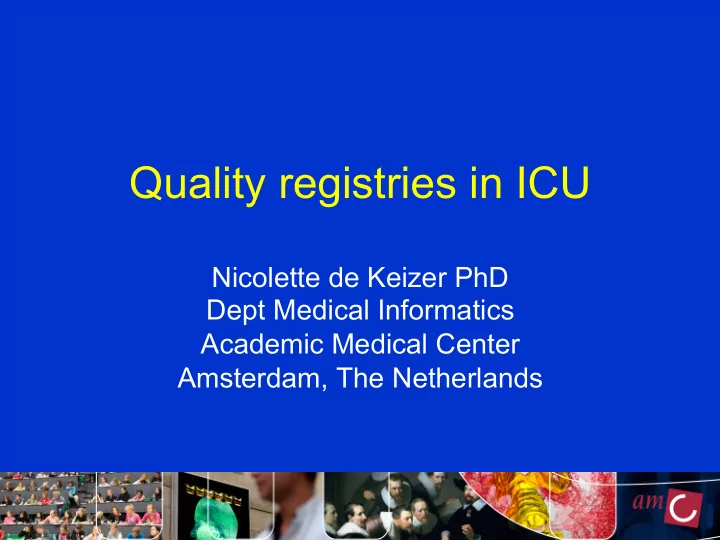

Quality registries in ICU Nicolette de Keizer PhD Dept Medical Informatics Academic Medical Center Amsterdam, The Netherlands
Knowledge
• No standard treatment Effective and Efficient? • Very expensive • Shortage of beds
Evaluating Quality of Care • Randomized Controlled Trials – Not ethical • Benchmarking – Compare to national average or best ICU – Monitor performance in time – Quality registry
Quality registry • Continuous data collection • Predefined data set • Multiple centers • Feedback and benchmark
Examples of quality registries e.g. TRACER Project Impact
State of the art registries • Many national quality registries • Some international initiatives – Project-based • Overlap in data collection • Differences in data items and data definitions • All have the same goal
Goal of ICU quality registries • To get insight into quality of intensive care – Quality indicators • To foster improvements in the organization and practice of intensive care – Benchmarking – Case mix correction – Statistical Process Control – Collaborative network
Goal of ICU quality registries • To get insight into quality of intensive care – Quality indicators • To foster improvements in the organization and practice of intensive care – Benchmarking – Case mix correction – Statistical Process Control – Collaborative network
Quality management Outcome Structure Process
Quality Indicator “ An measurable variable (or characteristic) that is used to determine the level of quality achieved“
Selection of Quality Indicators (1) • Association with outcome or a process/ structure indicator that is related to outcome • Relevant for clinical practice – frequency • Results in quality improvement activities • Easily measurable • Fast available • Applicable in several institutions
Example DMV • Mean duration of mechanical ventilation (DMV) of patients admitted at the ICU • Interpretation: • Mechanical ventilation? • Calculation: 1. Mean difference in fractional days between start and end time of (non-) invasive mechanical ventilation during an ICU admission 2. Same as 1, but also including non-ventilated patients (DMV=0) 3. Same as 1, but using calendar days instead of fractional days
Example indicator mean duration of mechanical ventilation fractional days* incl. DMV=0* p-value ** calendar days* DMV (days) 1.95 [0.59] 0.08 [0.13] 3.86 [0.70] <0.001
State of the art indicators • Many quality indicators • Ambigously defined • Indicators should be easily measurable, fast available, applicable in several institutions • -> Requires formalisation and automatic derivation of indicators based on routinely collected data
Goal of ICU quality registries • To get insight into quality of intensive care – Quality indicators • To foster improvements in the organization and practice of intensive care – Benchmarking – Case mix correction – Statistical Process Control
Measuring quality of care by indicators • External benchmark – Compare to peers • Internal benchmark – Compare own performance in time
Measuring quality of care by indicators • External benchmark
Measuring quality of care by indicators Case-mix corrected • External benchmark • Standardized mortality ratio= observed mortality / expected mortality
Case mix adjustment • Many different prognostic models: – APACHEII,III, IV, SAPSII,III, MPM0/24, LODS, SOFA, Euroscore etc. – Logistic regression models – Data of first 24 hours of ICU admission • Measure performance (discrimination, calibration, accuracy) • Recalibrate if needed
Statistical Process Control • Internal benchmark – Compare own performance in time – Variation in proces is noise or special cause – Detection rules e.g. 1 point cross UCL/LCL, 8 consequetive points below or under mean
VAP Cost Cost of VAP in Calgary Health Region VAP Total Cost / Year Each case of VAP = $14,000 extra expense for Health Care (Safer Healthcare Now) $300.000 $2.500.000 Total Case Cost (Cnd$) / Fiscal Year $2.338.000 $250.000 VAP Case Cost (Cnd$) $2.000.000 $200.000 $1.344.000 $1.500.000 $1.190.000 $150.000 $1.000.000 $100.000 $574.000 $434.000 $500.000 $50.000 $378.000 $0 $0 apr./06 jun./06 aug./06 okt./06 dec./06 apr./07 jun./07 aug./07 okt./07 dec./07 apr./08 jun./08 aug./08 okt./08 dec./08 apr./09 jun./09 aug./09 okt./09 dec./09 apr./10 jun./10 aug./10 apr./05 jun./05 aug./05 okt./05 dec./05 feb./06 feb./07 feb./08 feb./09 feb./10 Months of the Year 22 MIE 2011, 30 Aug, Oslo, Norway Reza.Shahpori@AlbertaHealthServices.Ca
State of the art SPC • Many types of charts – EWMA, CUSUM, RSPRT, P-charts etc – Risk adjusted or not • Limitly applied in critical care • Unknown what is the best chart to detect a decrease or increase in quality
Points of interest / discussion • Share datasets / indicator sets – Formalisation – Terminology • How to move from quality assessment to quality improvement – Internal or external benchmarking – Statistical process control – Collaborative networks
Recommend
More recommend